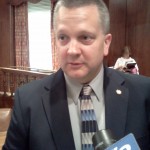Hearing to Kick-Start Legislative Downsizing Debate
There are seven bills before the House State Government Committee, each with a different approach to reducing the size of the General Assembly. “There’ve been many stories written about this issue; there’ve been citizens across the state – at various times – talking about this issue,” says committee chairman Daryl Metcalfe (R-Butler), who will convene a public hearing, Tuesday afternoon, in the House Majority Caucus Room.
Efforts to reduce the 253-member General Assembly have not gotten far in years past, but this year one of the bills is sponsored by Speaker of the House Sam Smith (R-Jefferson). Smith’s bill (HB 153) would amend the state constitution to reduce House membership from 203 to 153, following the 2020 Census. The Smith bill would only affect House districts, but others would trim the size of both chambers. For instance, HB 183 would result in 121 House seats and 30 Senate seats.
Pennsylvania’s cast of 253 lawmakers is the second only to New Hampshire’s 424. However, when population is factored in, Pennsylvania has the 7th most constituents per Senator and the 18th most constituents per State Rep.
Beverley Cigler, professor of public policy and administration at Penn State Harrisburg, says there’s no research showing that a smaller legislature is more efficient. She points to California. “It is an extremely large state. It has a House of 80-members and a Senate of 40, so it is a very small legislature, and I think by anybody’s measure they’re a mess.” Cigler is scheduled to testify before Metcalfe’s committee on Tuesday, and will suggest that other reforms are more promising for improving the legislature than downsizing.
For chairman Metcalfe, finances are top of mind. “I think it’s a prime opportunity to take a look at the plusses and minuses of reducing the size of the legislature, especially as it relates to the cost of our legislature, and ultimately the cost of our state government,” Metcalfe says. Most state spending falls under the executive branch and Metcalfe says that’s where the fat needs to be cut. “But the legislature needs to lead by example, and I think that’s what these proposals are trying to do.”











